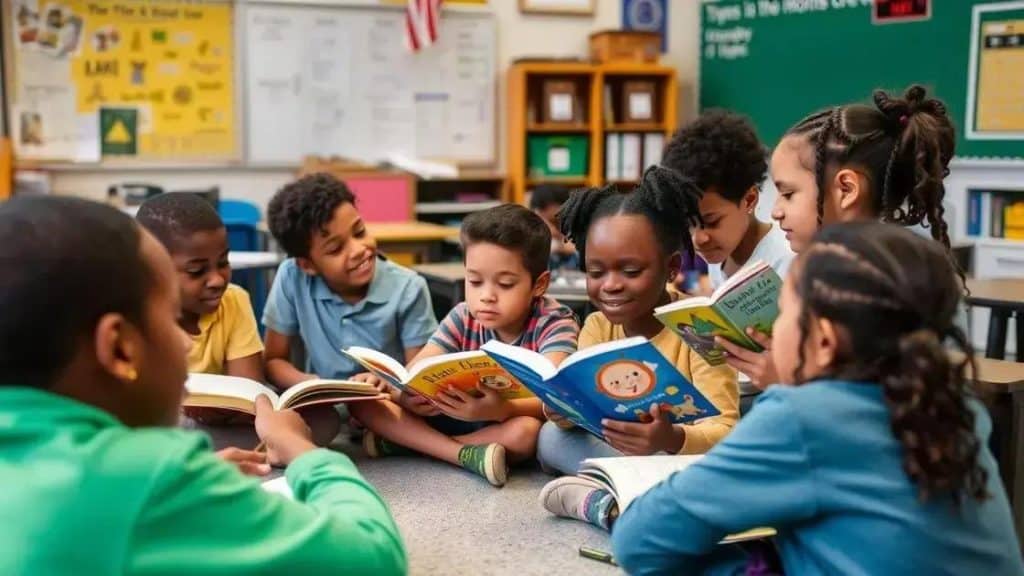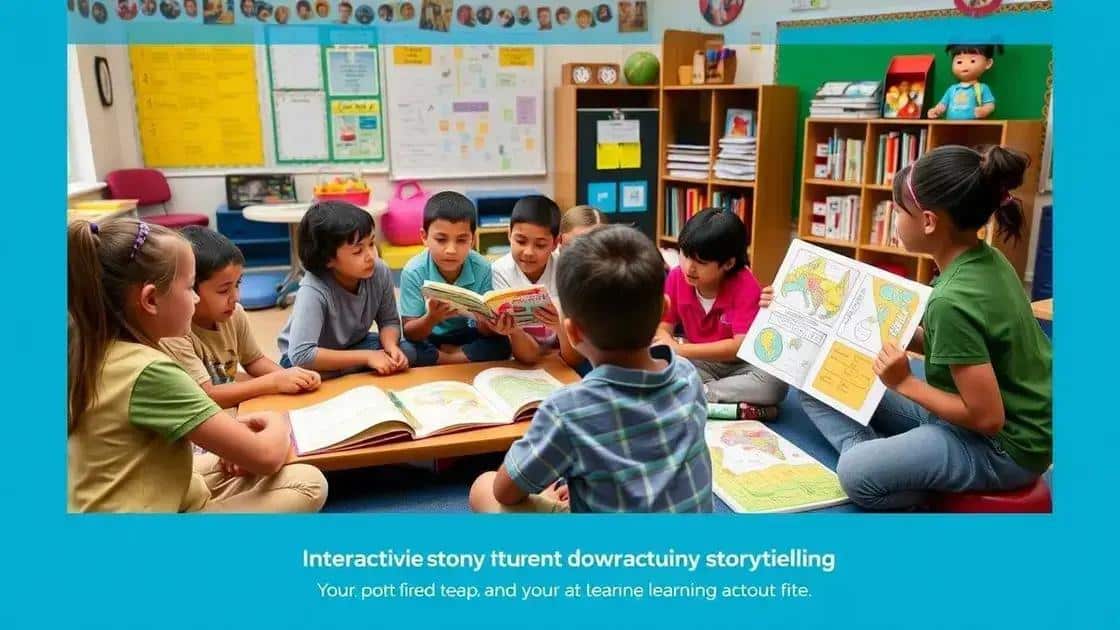Story curriculum improvement ideas to engage students

Story curriculum improvement ideas, such as incorporating student-generated narratives and multimedia storytelling, significantly enhance student engagement, creativity, and understanding in the classroom.
Story curriculum improvement ideas offer a fresh approach to engage students and enhance their learning experiences. Have you ever wondered how stories can enrich classroom lessons? In this article, we’ll explore innovative strategies to bring storytelling into education.
Integrating storytelling in lesson plans
Integrating storytelling in lesson plans can spark creativity and connection among students. When students hear a story, they connect better with the material. But how can teachers effectively weave narratives into their lesson plans?
Understanding the Benefits
Storytelling not only makes lessons more enjoyable but also helps clarify complex concepts. By embedding stories into lessons, students can relate personal experiences to the material, enhancing their understanding.
Key Strategies for Integration
- Start with a relatable story: Use a narrative that connects with students’ lives.
- Develop character-driven narratives: Create characters that students can relate to or find interesting.
- Encourage participation: Involve students in the storytelling process to boost engagement.
- Link stories to outcomes: Ensure the stories align with learning objectives.
Continuing this approach, teachers can ensure that stories are not just entertaining, but also educational. For example, when introducing historical events, embedding personal stories can make the past feel more alive. When students see history through a narrative lens, they often grasp the significance of events more profoundly.
Additionally, using storytelling to present problem-solving scenarios in subjects like math or science fosters critical thinking. By contextualizing a challenge within a narrative, students can explore solutions actively and collaboratively.
Tips for Effective Storytelling
Try these tips to enhance storytelling in your lessons. First, practice your delivery; a well-told story captures attention. Next, use visual aids or props to enrich the experience. Finally, allow for student feedback to make the experience more interactive and tailored to their interests.
Incorporating storytelling is not just about telling tales. It’s about creating meaningful connections that resonate with students, inspiring them to engage actively with their learning.
Using multimedia for enhanced storytelling
Using multimedia for enhanced storytelling can greatly enrich the educational experience. Integrating videos, images, and audio into lessons helps capture students’ attention and makes concepts more relatable. Just think about how a vivid image or a catchy sound can bring a story to life!
Benefits of Multimedia Storytelling
When you use different types of media, students can engage with the material on various levels. This multi-sensory approach caters to different learning styles. Some students may grasp information better through visuals, while others may prefer the narrative power of audio or video.
Effective Ways to Implement Multimedia
- Incorporate videos that illustrate key concepts in lessons.
- Use images that support the narrative to enhance understanding.
- Include audio clips that provide context or depth to stories.
- Utilize interactive tools that allow students to create their own multimedia projects.
To effectively weave multimedia into storytelling, consider the context. For instance, when teaching about nature, using videos of animals in their habitats can help students visualize the concepts. This approach not only engages but also encourages curiosity, prompting students to ask questions and explore further.
Moreover, students can create their own narratives using multimedia. By allowing them to choose their elements—like images or sounds—they take ownership of their learning. This way, they don’t just passively consume information; they actively participate in the storytelling process.
Challenges to Consider
While multimedia can enhance storytelling, it’s essential to be mindful of potential challenges. Not all students may have the same access to technology, which can create disparities. Teachers should aim to modify their plans to ensure that everyone can engage with the material equally.
Additionally, it’s important to maintain a balance. Overloading a lesson with multimedia may distract from the main message. The key is finding the right elements that support the story without overwhelming students.
Creating interactive story sessions

Creating interactive story sessions can transform the way students engage with narratives. By actively involving students in storytelling, you can enhance their understanding and retention of the material. Imagine a classroom where every student feels excited to contribute!
Importance of Interaction
Interactive story sessions promote collaboration and communication. When students interact with each other, they share ideas and develop their critical thinking skills. This approach allows them to think deeply about the story while expressing their thoughts creatively.
Techniques for Interactive Sessions
- Utilize role-playing to bring characters to life.
- Allow students to create story maps that visualize the plot.
- Incorporate audience participation by letting students choose the direction of the story.
- Use props or costumes to make the session more engaging.
In addition to these techniques, consider using technology to create immersive experiences. For instance, employing interactive whiteboards can allow students to illustrate the story visually while discussing it. This integration of technology deepens engagement and solidifies understanding.
Furthermore, using group storytelling can foster teamwork. Students can take turns adding to the story, which encourages listening and helps them build their ideas together. As they collaborate, they’ll learn how to craft a narrative and enhance their storytelling skills in the process.
Adapting to Students’ Needs
It’s crucial to adapt interactive sessions for different learning styles. Some students may shine in verbal storytelling, while others might prefer visual or kinesthetic approaches. Tailoring the activities ensures that every student has the opportunity to participate.
Ultimately, creating interactive story sessions is not just about telling a story; it’s about fostering an environment where students feel comfortable expressing themselves. By encouraging creativity and communication, you’ll see students develop a love for learning through stories.
Incorporating student-generated narratives
Incorporating student-generated narratives into the classroom can empower learners and enrich their educational experiences. When students create their own stories, they take ownership of their learning. This approach fosters creativity and self-expression, making lessons more engaging!
Benefits of Student-Generated Narratives
Allowing students to craft their narratives gives them a voice. Not only do they develop their writing skills, but they also learn to express their thoughts and feelings. Moreover, these narratives can better reflect their unique experiences, leading to deeper connections with the material.
Ways to Incorporate Narratives
- Encourage students to write personal stories related to lesson topics.
- Facilitate group projects where students collaboratively create stories.
- Use digital storytelling tools to bring their narratives to life.
- Host story-sharing sessions where students present their work.
As students work on their narratives, they learn essential skills like planning and revision. Writing their stories encourages them to think critically about structure and content. They also benefit from peer feedback, which can improve their writing and presentation skills.
Furthermore, integrating these narratives into lesson plans allows teachers to connect the curriculum to students’ lives. For example, when studying a historical event, students could write from the perspective of someone who lived through it. This approach encourages empathy and a deeper understanding of historical contexts.
Challenge of Implementation
While incorporating student-generated narratives is beneficial, it does come with challenges. Some students may struggle with writing or lack confidence in their storytelling abilities. Teachers should provide support and guidance, ensuring that every student feels empowered to share their voice.
To overcome these obstacles, consider hosting brainstorming sessions or using visual aids to help students organize their thoughts. These strategies can make the process more accessible and enjoyable for all learners.
Assessing the impact of story-based learning
Assessing the impact of story-based learning is crucial in understanding its effectiveness in the classroom. By evaluating how stories influence student engagement and retention, educators can enhance their teaching methods. How does storytelling shape a student’s learning experience?
Measuring Engagement
One way to assess the impact is by measuring student engagement during storytelling sessions. Observations can help teachers see if students are actively participating and how invested they are in the narratives. When students are engaged, they tend to absorb information more effectively.
Retention and Understanding
Retention is another key factor. Educators can evaluate how well students remember the material presented through stories. This can be done through quizzes or discussions about the stories and their related concepts. If retention is high, it indicates that story-based methods are likely effective.
- Conduct pre- and post-assessments to measure knowledge gains.
- Utilize student reflections to gather personal insights on learning.
- Compare results with traditional teaching methods.
Moreover, assessing understanding can also involve creative assignments that allow students to express what they learned through storytelling. For instance, having students create their own stories related to the topics can give insights into their comprehension.
Another way to assess the impact of story-based learning is to gather feedback from students. Surveys can help educators understand how the use of storytelling influences their perceptions of learning. Students may express preferences for learning through stories over traditional methods.
Challenges in Assessment
While assessing story-based learning can provide valuable insights, there are challenges to consider. Some students may respond differently to narratives based on their backgrounds or experiences. It’s important to ensure that stories are inclusive and resonate with all learners.
Additionally, the subjective nature of storytelling can make it hard to measure impact quantitatively. Therefore, combining quantitative and qualitative assessments is recommended for a more comprehensive view of story-based learning’s effectiveness.
Incorporating storytelling into the classroom has a profound effect on learning. With techniques like student-generated narratives and multimedia storytelling, teachers can boost engagement and understanding. By assessing the impact of these methods, educators can refine their teaching strategies and enhance student experiences. Ultimately, storytelling fosters creativity, critical thinking, and a love for learning in students.
FAQ – Frequently Asked Questions about Story-Based Learning
How does storytelling enhance student engagement?
Storytelling makes lessons more relatable, capturing students’ interest and encouraging participation.
What are the benefits of student-generated narratives?
Student-generated narratives promote creativity, self-expression, and help students take ownership of their learning.
How can multimedia tools improve storytelling in the classroom?
Multimedia tools like videos and images enrich storytelling, making lessons more dynamic and engaging for all learners.
What methods can be used to assess the impact of story-based learning?
Teachers can use quizzes, student reflections, and feedback surveys to evaluate how storytelling affects engagement and retention.





